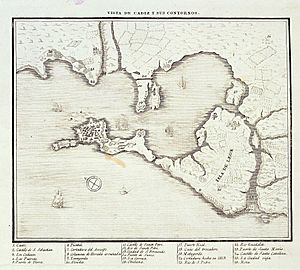Capture of the Rosily Squadron facts for kids
The Capture of the Rosily Squadron was a naval battle that happened in Cádiz, Spain, on June 14, 1808. It was also known as the Battle of Poza de Santa Isabel. In this battle, Spanish forces fought against a French fleet. The French ships had been stuck in the port of Cádiz since the Battle of Trafalgar almost three years earlier. After five days of fighting, French Admiral François Étienne de Rosily-Mesros surrendered his entire fleet and all 4,000 sailors. This event was an important part of the Peninsular War, which was a big conflict between France and Spain.
Quick facts for kids Capture of the Rosily Squadron |
|||||||
|---|---|---|---|---|---|---|---|
| Part of the Peninsular War | |||||||
 Map of Cádiz |
|||||||
|
|||||||
| Belligerents | |||||||
| Commanders and leaders | |||||||
| Strength | |||||||
| 5 ships of the line, 1 frigate, 4,000 sailors |
5 ships of the line, 1 frigate At least 2,000 sailors and militia, Numerous gunboats |
||||||
| Casualties and losses | |||||||
| 13 dead, 46 wounded, 3,676 captured, 6 ships captured Total: 3,735 |
4 dead, 50 wounded, 15 gunboats sunk Total: 54 |
||||||
Contents
Why the Battle Happened
The Peninsular War was a big conflict in Europe. It started when France, led by Napoleon, tried to take control of Spain. In the spring of 1808, relations between Spain and France got much worse. This led to many rebellions in Spain against the French. The French then occupied Spain and put Napoleon's brother, Joseph Bonaparte, on the Spanish throne.
French Admiral Rosily had five large warships and one smaller ship in Cádiz. These ships had been trapped there for a long time. Rosily tried to buy time for French troops to arrive from Madrid. He moved his ships to a safe spot in the channel near La Carraca.
Rosily first offered to leave the bay to calm the angry crowds. Then, he suggested to the British navy, who were blocking the port, that he would remove his cannons from the ships. He wanted to keep his crew on board and hide his flag. In return, he asked for safety for his sick sailors and French people in Cádiz. The British did not agree to this.
The Spanish governor of Cádiz, Tomás de Morla y Pacheco, refused Rosily's demands. Instead, he told Rosily to surrender his entire force. When Rosily said no, the Spanish set up cannons on the Isle of Leon and near Fort Louis. They were ready to fight.
French Ships in Cádiz
The French fleet in Cádiz included several powerful warships. Here are the names of the ships and how many cannons they had:
- Neptune: 80 cannons
- Héros: 74 cannons
- Pluton: 74 cannons
- Algesiras: 80 cannons
- Argonaute: 74 cannons
- Cornélie: 44 cannons (a smaller, faster ship)
The Battle Begins
The fighting started on June 9 at 3 PM. Spanish gunboats and mortar boats, along with cannons on the Isle of Leon and at Fort Louis, began firing at the French ships. They kept shooting until night. The Spanish even asked two of their own large warships, Principe de Asturias (112 cannons) and Terrible (74 cannons), to help them.
The next morning, June 10, the firing started again. It continued until 2 PM. Then, the French flagship, Héros, raised a white flag, which meant they wanted to talk. Admiral Rosily sent a letter to Governor Morla. He offered to take his cannons and ammunition off his ships. But he wanted to keep his men and not fly any flags.
The Spanish thought these terms were not good enough. They got ready to attack the French fleet with even more power. By June 14, at 7 AM, a new battery of 30 large cannons was ready. Many more gunboats and mortar vessels also got into position. Seeing this, the French ships lowered their flags, which meant they surrendered. Later that morning, Spanish flags were raised on the captured French ships.
The British navy was watching the battle from a distance. Admiral Collingwood, who was in charge of blocking Cádiz, offered to help. But the Spanish refused his offer. They wanted to capture the French ships themselves without British help. This way, the British would not have any claim to the captured ships.
The French did not lose many lives in the battle. The Spanish only had four men killed. Governor Tomás Morla did not want to destroy the French ships completely. He knew his forces would win easily, so he did not use more damaging methods, like heated shot (cannonballs heated until they were red-hot).
What Happened Next
After the French fleet surrendered, the Spanish government asked the British Admiral for help. They wanted to send people on a British ship to talk with the British government. Their goal was to form an alliance against Napoleon.
Mr. George Canning, who was the British Foreign Secretary, made an important statement. He said that Britain would no longer remember the past wars with Spain. He declared that any country that fought against France's huge power would become a natural ally of Great Britain.
On July 4, the British government officially announced that all fighting between Great Britain and Spain would stop right away. This marked a new friendship between the two countries against France.
See also
 In Spanish: Batalla de la Poza de Santa Isabel para niños
In Spanish: Batalla de la Poza de Santa Isabel para niños

